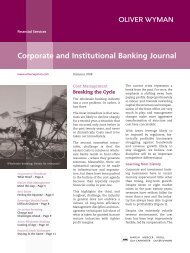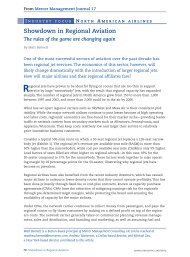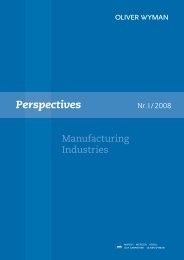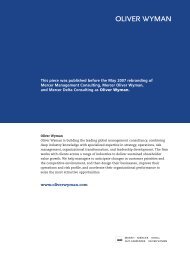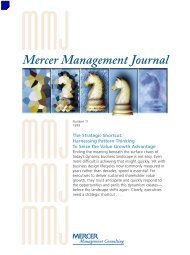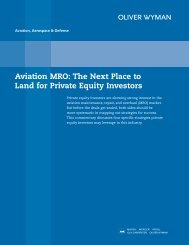Download the Report - Oliver Wyman
Download the Report - Oliver Wyman
Download the Report - Oliver Wyman
You also want an ePaper? Increase the reach of your titles
YUMPU automatically turns print PDFs into web optimized ePapers that Google loves.
Portfolio redesign at Royal Dutch/Shell<br />
Mercer Management<br />
Consulting has been<br />
working with <strong>the</strong> Royal<br />
Dutch/Shell Group since<br />
1999 to change <strong>the</strong> way<br />
<strong>the</strong> company thinks<br />
about portfolio strategy.<br />
Royal Dutch/Shell has<br />
worldwide operations in<br />
oil, chemicals, gas, and<br />
o<strong>the</strong>r energy-related<br />
Roxanne Decyk products and services, as<br />
well as smaller ventures in o<strong>the</strong>r industries.<br />
Headquartered in <strong>the</strong> Ne<strong>the</strong>rlands and <strong>the</strong> United<br />
Kingdom, Royal Dutch/Shell reported adjusted net<br />
income of $13.1 billion in 2000 on revenues of<br />
$191.5 billion. Roxanne Decyk, <strong>the</strong> firm’s vice<br />
president for corporate strategy, spoke recently<br />
with Mercer about <strong>the</strong> evolution of portfolio<br />
thinking at Royal Dutch/Shell.<br />
Q. What was Shell’s traditional approach to<br />
portfolio strategy, and how have you been<br />
changing it?<br />
A. We look at our portfolio in terms of <strong>the</strong> global<br />
business descriptions that had been adopted over<br />
<strong>the</strong> past five years or so—our upstream business,<br />
our downstream business, our chemicals business,<br />
our renewables business, and so on. It’s a classic<br />
industry structure, which we still use, in part<br />
because this is how <strong>the</strong> analyst community thinks<br />
about it. Analysts can compare our performance<br />
in each segment against competitors.<br />
But for internal purposes, around 1998 we<br />
became concerned that this traditional view was<br />
preventing us from seeing common problems that<br />
would cut across those businesses. There might be<br />
issues common to a class of customer that exist in<br />
all <strong>the</strong> businesses, or around organizational capabilities<br />
across those businesses. In a classically<br />
defined portfolio, we wouldn’t see <strong>the</strong>m as common<br />
issues.<br />
Ano<strong>the</strong>r concern was that because <strong>the</strong> traditional<br />
portfolio approach starts with <strong>the</strong> assets we own,<br />
our expectations about <strong>the</strong> future were grounded<br />
in how those assets had performed in <strong>the</strong> past.<br />
Yet <strong>the</strong> evidence shows that future performance<br />
for asset-based companies is highly unpredictable.<br />
Many companies have faced significant discontinuities<br />
because a projection of historical performance<br />
of assets or products was completely disrupted<br />
by changes in customer expectation, or<br />
o<strong>the</strong>r environmental factors, that couldn’t even<br />
be isolated or identified based on <strong>the</strong> way portfolios<br />
were defined and performance was tracked.<br />
The concept of starting with <strong>the</strong> customer and<br />
working back, as opposed to working forward<br />
from assets, was intuitively appealing.<br />
Q. How does this play out in one line of business?<br />
A. Chemicals is a good example. There had been a<br />
steady effort over part of <strong>the</strong> decade to improve<br />
results by doing a lot of aggressive portfolio management,<br />
especially to get rid of underperforming<br />
units. When we began to identify what might be<br />
<strong>the</strong> portfolio of business designs in <strong>the</strong> chemicals<br />
business, as opposed to <strong>the</strong> portfolio of products,<br />
it became clear that <strong>the</strong> strategies adopted to<br />
improve performance were necessary but not sufficient<br />
to give us strategic advantage in <strong>the</strong> long run.<br />
In some cases, we honed in on <strong>the</strong> “collapse of<br />
<strong>the</strong> middle” problem, where at <strong>the</strong> low end value<br />
is based on price, at <strong>the</strong> high end on delivering<br />
solutions, and sometimes Shell was in <strong>the</strong> middle,<br />
which is untenable. Understanding <strong>the</strong> implications<br />
of those business designs, and some of <strong>the</strong><br />
threats, caused our managers to consider different<br />
actions to improve our position.<br />
Q. What o<strong>the</strong>r insights does <strong>the</strong> business design<br />
perspective provide?<br />
A. In our portfolio, not surprisingly, we have many<br />
more asset-based business designs than knowledge-based<br />
business designs. Now we’re better<br />
able to understand which of <strong>the</strong> asset-based<br />
designs have real promise to evolve. We can think<br />
about creating value out of <strong>the</strong> set of skills, capabilities,<br />
and technologies around that asset-based<br />
business, and build a knowledge game on top of it.<br />
Q. Is a knowledge-based business design potentially<br />
more valuable than an asset-based business<br />
design, or just a different way to create value?<br />
A. It depends. We do have very high value assetbased<br />
business designs, which will be part of our<br />
portfolio for a long time. But knowledge-based<br />
business designs tend to be attractive in two ways.<br />
First, capital discipline is important to Shell, so we<br />
need to find ways to grow value outside of capital-intensive<br />
areas. In <strong>the</strong> oil industry, we know<br />
10 Portfolio redesign Mercer Management Journal



